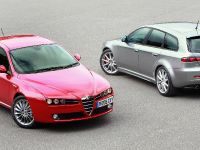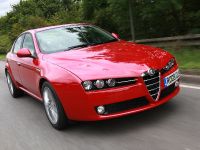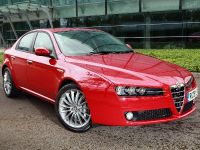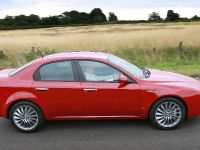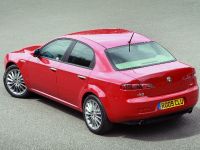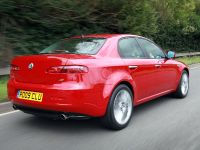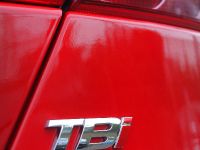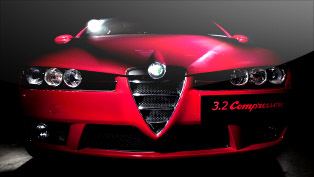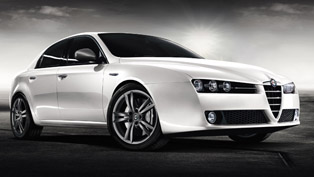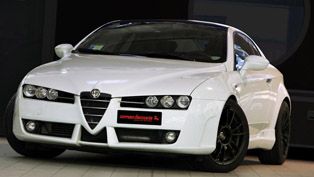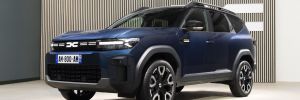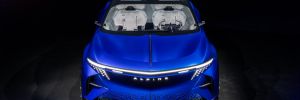Alfa Romeo 159 with whole new range of engines
Turbo-charging will take place in almost every new engine developed by manufacturers. It is very useful way for boosting the engine power and lowering the consumption and harmful emissions.
The engineers from Alfa Romeo are bringing to your attention their new 1750 TBi – 200bhp petrol engine and the 2.0JTDm diesel with 170bhp.
The 1750TBi is achieving it's maximum torque of 320Nm at just 1400rpm, which is amazing for a petrol engine. This means that you can easily accelerate and take over at greater gear without any difficulties. The emissions are as low as 189 g/km, which means lower taxes and environmentally friendly car. The sporty character is underlined by the typical discipline 0-62mph come just in 7.7 seconds.
Last, but not least, the 1750 TBi has a mileage extension to 21,000 miles between routine maintenance intervals.
The 2.0JTDm common rail diesel has 170bhp and delivers 360Nm of torque. It covers 0 – 62 mph sprint in 8.8 seconds and the CO2 emissions have been reduced to just 142 g/km. This amazing results are achieved by increasing the displacement from 1910 to 1956 cc. The size of the bore is extended from 82 mm to 83 mm. It is also used a new variable geometry turbo.
Adding to the driver appeal of the new 170 bhp 2.0 JTDM version, routine maintenance intervals have been extended to 21,000 miles.
THE 159 RANGE
| Alfa 159 Saloon | TotalOTR £ | Alfa 159 Sportwagon | TotalOTR £ | |
| 1.9 JTDM 120 BHP ECO TURISMO | 19950 | 1.9 JTDM 120 BHP ECO TURISMO | 21050 | |
| 1.9 JTDM 120 BHP ECO TURISMO SPORT | 20750 | 1.9 JTDM 120 BHP ECO TURISMO SPORT | 21850 | |
| 1.9 JTDM 150 BHP TURISMO | 20700 | 1.9 JTDM 150 BHP TURISMO | 21800 | |
| 1.9 JTDM 150 BHP TURISMO SPORT | 21500 | 1.9 JTDM 150 BHP TURISMO SPORT | 22600 | |
| 1.9 JTDM 150 BHP ELEGANTE | 21650 | 1.9 JTDM 150 BHP ELEGANTE | 22750 | |
| 1.9 JTDM 150 BHP LUSSO | 22750 | 1.9 JTDM 150 BHP LUSSO | 23850 | |
| 1.9 JTDM 150 BHP TI | 23850 | 1.9 JTDM 150 BHP TI | 24950 | |
| 1.9 JTDM 150 BHP QTRONIC ELEGANTE | 23100 | 1.9 JTDM 150 BHP QTRONIC ELEGANTE | 24200 | |
| 1.9 JTDM 150 BHP QTRONIC LUSSO | 24200 | 1.9 JTDM 150 BHP QTRONIC LUSSO | 25300 | |
| 1.9 JTDM 150 BHP QTRONIC TI | 25300 | 1.9 JTDM 150 BHP QTRONIC TI | 26400 | |
| 2.0 JTDM 170 BHP TURISMO | 21800 | 2.0 JTDM 170 BHP TURISMO | 22900 | |
| 2.0 JTDM 170 BHP TURISMO SPORT | 22600 | 2.0 JTDM 170 BHP TURISMO SPORT | 23700 | |
| 2.0 JTDM 170 BHP ELEGANTE | 22750 | 2.0 JTDM 170 BHP ELEGANTE | 23850 | |
| 2.0 JTDM 170 BHP LUSSO | 23850 | 2.0 JTDM 170 BHP LUSSO | 24950 | |
| 2.0 JTDM 170 BHP TI | 24950 | 2.0 JTDM 170 BHP TI | 26050 | |
| 2.4 JTDM 210 BHP ELEGANTE | 24150 | 2.4 JTDM 210 BHP ELEGANTE | 25250 | |
| 2.4 JTDM 210 BHP LUSSO | 25250 | 2.4 JTDM 210 BHP LUSSO | 26350 | |
| 2.4 JTDM 210 BHP TI | 26350 | 2.4 JTDM 210 BHP TI | 27450 | |
| 2.4 JTDM 200 BHP QTRONIC ELEGANTE | 25600 | 2.4 JTDM 200 BHP QTRONIC ELEGANTE | 26700 | |
| 2.4 JTDM 200 BHP QTRONIC LUSSO | 26700 | 2.4 JTDM 200 BHP QTRONIC LUSSO | 27800 | |
| 2.4 JTDM 200 BHP QTRONIC TI | 27800 | 2.4 JTDM 200 BHP QTRONIC TI | 28900 | |
| 2.2 JTS 185 BHP ELEGANTE | 21450 | 2.2 JTS 185 BHP ELEGANTE | 22550 | |
| 2.2 JTS 185 BHP LUSSO | 22550 | 2.2 JTS 185 BHP LUSSO | 23650 | |
| 2.2 JTS 185 BHP TI | 23650 | 2.2 JTS 185 BHP TI | 24750 | |
| 1750 TBI 200 BHP TURISMO | 21800 | 1750 TBI 200 BHP TURISMO | 22900 | |
| 1750 TBI 200 BHP TURISMO SPORT | 22600 | 1750 TBI 200 BHP TURISMO SPORT | 23700 | |
| 1750 TBI 200 BHP ELEGANTE | 22750 | 1750 TBI 200 BHP ELEGANTE | 23850 | |
| 1750 TBI 200 BHP LUSSO | 23850 | 1750 TBI 200 BHP LUSSO | 24950 | |
| 1750 TBI 200 BHP TI | 24950 | 1750 TBI 200 BHP TI | 26050 | |
| 3.2 JTS 260 BHP ELEGANTE | 25600 | 3.2 JTS 260 BHP ELEGANTE | 26700 | |
| 3.2 JTS 260 BHP LUSSO | 26700 | 3.2 JTS 260 BHP LUSSO | 27800 | |
| 3.2 JTS 260 BHP TI | 27800 | 3.2 JTS 260 BHP TI | 28900 |
